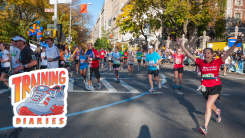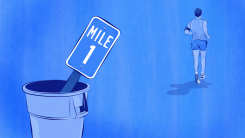Meredith’s Training Diaries: My Marathon Post-Mortem

This is Training Diaries, a Lifehacker series about my journey to the 2023 TCS New York City Marathon. This series will cover all the ups, downs, and hill repeats on my journey to the biggest marathon in the world. Leading up to race day on Sunday, Nov. 5, I’ll go over proper fueling, injuries and setbacks, treadmill tips, wardrobe malfunctions, long run logic, and just generally reflect on what it takes to cross a marathon finish line. I’m guided by a mantra both corny and true: A marathon is actually hundreds of miles; race day just happens to be the last 26 or so.
It’s been nearly one week since I ran the New York City marathon. For a number of reasons—both emotional and physical—this is the first day I’ve been able to sit down and write about it. Part of me would prefer to run the course again rather than describe the race day experience and come up short. But since my quads are still refusing to allow me to walk up or down stairs, it looks like I’m faced with doing the one thing harder than running: Writing about running.
The high highs and the low lows
Out of all my (now five) marathons, this past Sunday delivered my highest highs and lowest lows. I’ll kick off by saying this: The real stars of the NYC marathon are the spectators. Aside from on the bridges, there was no gap along the course unfilled by people cheering, singing, screaming, laughing, and/or crying. One friend described it as getting a five-hour long hug from the entire city. Personally, I felt I was like running on stage.
And I am uniquely situated to make this claim, since as a comedian, I do get up on a stage every night. In fact, I was on stage doing standup not 12 hours before the marathon started. My set suffered from pre-race nerves, and my race suffered from post-show exhaustion. Would I recommend this combo to any other comic or runner? I wouldn’t. Would I do this to myself again? Definitely! I’m going to live forever!
It’s widely accepted in the racing community that what sets the New York marathon apart from all other races are the New Yorkers. And while the crowds brought runners the emotional support necessary to keep moving for hours, personally, the crowd’s energy sent my heart rate through the roof. Rather than relaxing into my race pace, my body was clenched the whole time.
This wasn’t my first time running an “off” race—I ran the Portland marathon in 2021 right after getting over a cold, and things that day never “clicked.” I’ve heard other runners describe it as failing to find their rhythm. When it happens, the only thing you can do is accept it as a final mental obstacle you’ll be battling throughout your race.
I was lucky to have friends and supporters spaced out along the course. Nothing puts a pep in your step like overwhelming gratitude for people you love! Even if you aren’t seeing your own loved ones, imagine spending an entire race watching heartfelt airport reunions—it’s a lot more encouraging that the podcasts I downed during training runs.
The absolute highlight of my day was seeing a large group of friends alongside my dad at mile 18. This mile marker is critical—for many runners, it’s the longest distance they hit during training, and yet there remains a daunting number of miles to go. Seeing those people at that point in the race sent my adrenaline skyrocketing. You know when a dog gets overstimulated and starts zooming around in circles? Let’s just say there’s now a video of me doing an impulsive handstand at mile 18. (This was a good decision. I in no way spent the next day projectile vomiting.)
Post-race recovery, and the so-called “runner’s flu”
The first half of the race passed quickly. From mile 18 to the finish line, I was forced to accept that I was embarking on the most uncomfortable hour of my life. By the end, I was borderline dissociating—I didn’t even realize I passed friends at mile 25 who were trying to get my attention. They described me as “inaccessible.” Fair enough—at this point, the only thing going through my head was that I needed to dig deeper. I tuned out the crowd and the runners around me. All I knew was that I had two feet I needed to keep picking up and putting in front of me for another mile. And then I crossed the finish line. I’m emotional now, but in the moment, it was anti-climactic. I was just ready to be done and lying horizontal somewhere, anywhere. And then, the vomiting.
So let’s get to the bottom of why I started puking, and why I still can’t seem to keep solid food down post-race.
I would argue (and many runners would agree) that the ideal marathon temperature is around 50°F. Sunday’s race was around 65°F. Gorgeous for spectating; surprisingly brutal for running. Laying out my clothes the night before, I had to choose between leggings and shorts. Two potential evils lay before me: Overheating versus chafing. I opted for being too warm. As a consequence of the heat, I accidentally drank way too much water throughout the race. (Remember: Nothing new on race day. This includes your hydration strategy and the number of impromptu handstands.)
The day after the marathon, I ate an average portion of eggs and breakfast potatoes, and it was all downhill from there. I was bed-ridden with intense stomach pain and other flu-like symptoms until finally, it all came up via the aforementioned projectile vomiting.
What is “runner’s flu”?
Apparently, I was experiencing the so-called “runner’s flu,” which is a very real phenomenon. Runner’s flu describes a combination of symptoms that often occur as the body recovers from the intense exertion of running for an extended period of time. The most common symptoms include:
-
Extreme fatigue and lethargy
-
Body aches and muscle soreness
-
Slight fever or chills
-
Cough or sore throat
-
Headaches
-
Loss of appetite
-
Mild nausea
These symptoms are caused by the stress running a marathon places on the body. During the race, the immune system is suppressed due to the exertion of high intensity exercise, leaving runners vulnerable to illness afterwards. The exaggerated inflammatory response and fluid shifts that occur can also cause flu-like symptoms.
While the experience has been unpleasant, I’m already on the mend. I’ve prioritized proper rest and recovery techniques, which I’ll dive into below.
The best ways to recover from a marathon
Here are some time-based tips for recovering after your big race.
The first 48 hours
-
Keep moving. Walk for 10-15 minutes after finishing the race to help flush lactic acid out of your legs and prevent your muscles from tightening up.
-
Hydrate and refuel. Drink plenty of fluids and eat a balanced meal with carbs and protein within 2 hours of finishing the race. This will help replenish glycogen stores and aid muscle recovery. Good options include chocolate milk, yogurt, eggs, and a banana.
-
Ice your legs. Apply ice packs to your quads, hamstrings, calves for 15-20 minutes several times in the first 48 hours post-race. This can help reduce inflammation. Compression socks may also help.
-
Elevate your legs. Whenever you are sitting or lying down, try to keep your legs elevated above heart level to improve circulation and minimize swelling.
-
Take anti-inflammatories. Over-the-counter meds like ibuprofen or naproxen can help with soreness and swelling. Follow dosage instructions.
-
Get a massage. Schedule a sports massage within the first few days after the marathon if possible. This can help decrease swelling and prevent tightness.
The first week
-
If you do run, take it easy. Do not run at all for the first 2-3 days, then start with 30-45 minutes of slow, easy jogging to get your legs moving again. Build back up gradually.
-
Cross-train. Swimming, cycling, or other low-impact activities can promote blood flow without over-stressing your body during the first week.
-
Stretch daily. Focus on major muscle groups like calves, hamstrings, quads, hips. This maintains flexibility.
-
Prioritize sleep. Get 8-10 hours per night to allow your body to fully recover. Nap if you can too!
-
Eat well. Continue eating nutrient-dense whole foods to aid muscle repair. Get plenty of protein. I for one lean on easy-to-digest smoothies, eggs, yogurt, and nut butters.
-
Consider other recovery aids. Try an Epsom salt bath, massage gun, or cupping therapy if you have access to these.
Listen to your body during the recovery process. Avoid intense or high-impact workouts until you start to feel normal again. Be patient—it takes time to bounce back after a marathon.
The bottom line
New York was my slowest race to date, and it delivered my toughest recovery experience, one I hope I never relive. It was also my most rewarding race, and I would 100% do it again. I don’t think there’s any amount of vomit that can keep me from signing up for another marathon. I believe training for a marathon gifts you one thing—besides sore muscles—and that’s perspective. (And if marathon training takes one thing from you, it’s your toenails. Who needs ‘em?)



